Table of Contents
- Introduction
- Editor’s Choice
- Global Employee Engagement Statistics
- Employee Engagement Software Market Statistics
- Most Important Attributes for Employees When Choosing a Job Worldwide
- Employee Engagement Software in Delivering Customer Experience (CX) Worldwide – By Country Statistics
- Job Satisfaction and Security Among Digital Workers Worldwide
- Engaging Training Formats for Employees
- Main Reasons for Using Online Feedback Tools in Organizations
- Use of Social Media in Employee Training
- Work Environment Benefits Through Technology
- Employee Satisfaction with Reskilling and Upskilling Training at their Workplace
- Key Spending and Investments
- Challenges and Concerns
- Innovations and Developments in Employee Engagement Software Statistics
- Regulations for Employee Engagement Software Statistics
- Recent Developments
- Conclusion
- FAQs
Introduction
Employee Engagement Software Statistics: Employee engagement software is a vital tool for enhancing the relationship between organizations and their employees.
Its primary purpose is to improve communication, foster collaboration, and measure engagement levels through features such as surveys, recognition programs, performance management, and learning resources.
By facilitating open dialogue and acknowledging employee achievements. Organizations can increase retention rates and productivity while cultivating a positive workplace culture.
Furthermore, the analytics capabilities of this software provide actionable insights for data-driven decision-making.
Current market trends emphasize mobile accessibility, artificial intelligence, and a focus on mental health. Reflecting the evolving needs of the modern workforce.
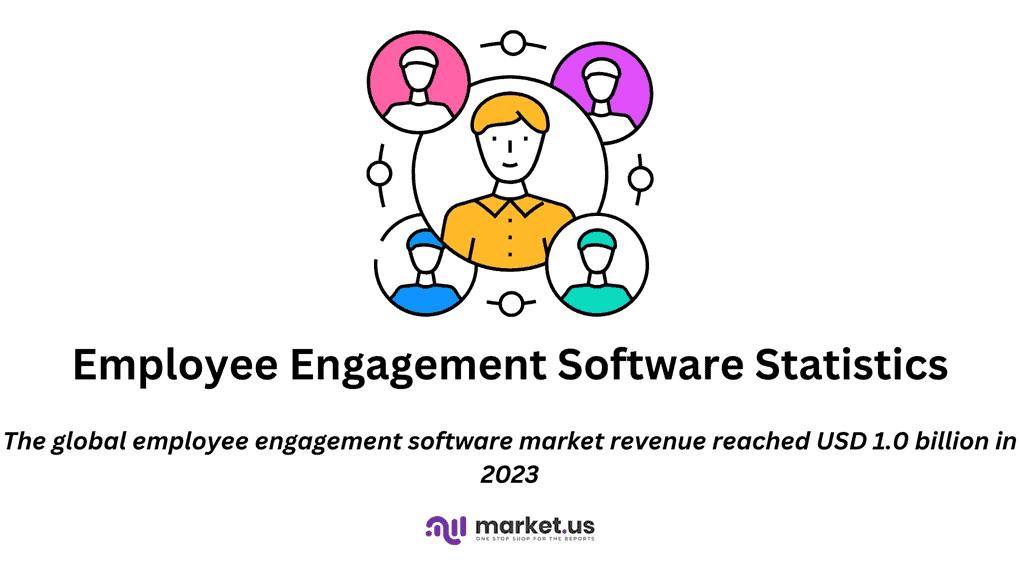
Editor’s Choice
- The global employee engagement software market revenue reached USD 1.0 billion in 2023.
- By 2033, the global market is expected to reach USD 3.8 billion, with cloud-based solutions making up USD 2.55 billion of that total. While on-premises deployments are projected to generate USD 1.25 billion.
- The global employee engagement software market shows a clear divide by enterprise size, with large enterprises holding 70.6% of the market share.
- In 2021, employee engagement in delivering customer experience (CX) varied globally, with Brazil leading at 62.5% highly engaged employees.
- In 2022, job satisfaction and security varied by digital proficiency, with 72% of advanced digital workers rating both aspects highly on a 0-10 scale.
- In 2020, 57% of employees identified collaboration devices that automatically pair with personal devices as a key technology for improving their work environment.
- In 2020, learning and development (L&D) professionals faced key challenges, with 49% of respondents highlighting the difficulty of getting managers to prioritize learning for their teams. Underscoring the importance of leadership in fostering employee development.
- In 2024, companies worldwide plan to focus their recruiting investments on several key procedures. Leading the list, 33.23% of respondents indicated plans to invest in AI tools. Reflecting the growing importance of automation and machine learning in recruitment processes.
- In 2024, organizations worldwide plan to invest in various areas to boost productivity. Leading the priorities is employee upskilling and reskilling, with 51% of respondents focusing on enhancing workforce skills.
- In the U.S., compliance with the ADA and Section 508 is essential to ensure employee engagement software is accessible. Featuring text alternatives and keyboard navigation for individuals with disabilities.
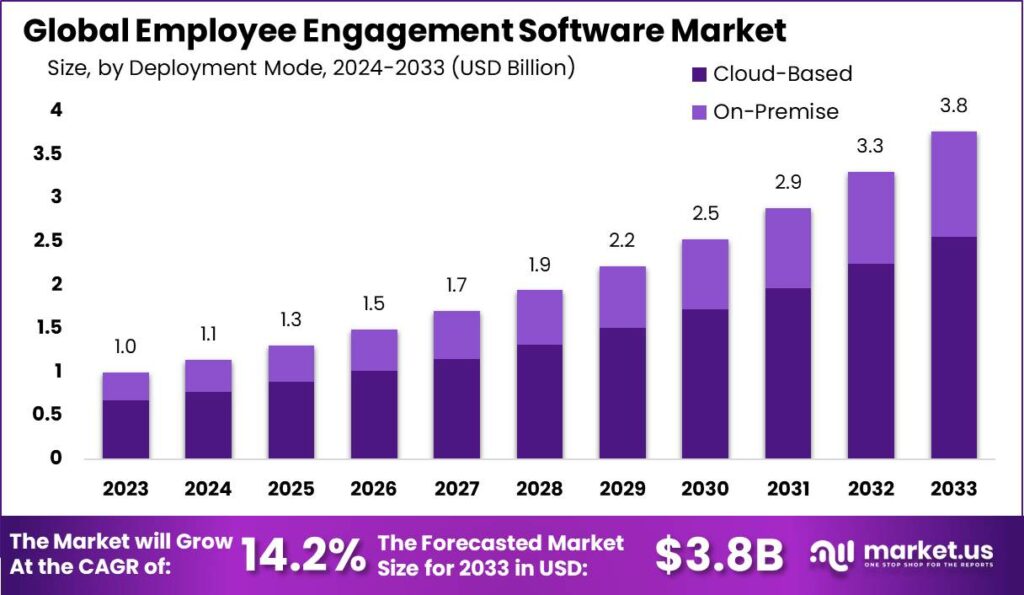
Global Employee Engagement Statistics
Software Engagement Score of Employee Worldwide Statistics
- The global employee engagement score has shown a fluctuating yet upward trend from 2011 to 2023.
- In 2011, the engagement score was recorded at 59%, slightly declining to 58% in 2012.
- However, the score rebounded in 2013, increasing to 60%, and continued its upward trajectory, reaching 62% in 2014.
- By 2015, employee engagement had risen to 65%, marking a significant improvement. Though it saw a slight dip to 63% in 2016.
- From 2017 through 2019, the engagement score stabilized at 65% before further increasing to 67% in 2019.
- In 2020, a marked rise was observed, with engagement reaching 69%. Possibly influenced by the global shift in work environments during the COVID-19 pandemic. Which prompted a stronger focus on employee well-being and connection.
- The engagement score remained high, standing at 68% in 2021. Before slightly decreasing to 67% in both 2022 and 2023.
- Overall, while there have been fluctuations, the global employee engagement score has shown consistent long-term growth over the past decade. Reflecting organizations’ increasing emphasis on employee satisfaction and workplace experience.
(Source: Statista)

Software Engagement Score of Employee Worldwide – By Region Statistics
- The engagement scores of employees across different global regions from 2012 to 2022 reveal a varied and evolving landscape.
- In Asia-Pacific, the employee engagement score began at 59% in 2012 and gradually increased over the years. Peaking at 71% in 2021 before slightly dropping to 68% in 2022.
- Latin America consistently showed strong engagement, starting at 71% in 2012 and maintaining high levels through 2020, where it reached a peak of 77%. However, a significant decline was observed in 2022. Where the score dropped to 63%.
- In North America, engagement started at 60% in 2012 and showed steady growth, reaching 70% by 2020. However, in subsequent years, the score declined slightly to 64% in 2021 and further to 61% in 2022.
- In Europe, employee engagement fluctuated more noticeably. Starting at 52% in 2012 and reaching 62% by 2020, but it declined to 52% again by 2022.
- Sub-Saharan Africa showed consistent improvement over the years. Starting at 52% in 2012, reaching a peak of 71% in 2020, and slightly dropping to 68% in 2022.
- The Middle East and North Africa (MENA) region displayed significant fluctuations, with engagement starting at 52% in 2012 and climbing to 73% by 2020. However, this region also experienced a sharp decline, with engagement scores falling to 55% by 2022.
- Overall, the data illustrates that while some regions, such as Latin America, North America, and the MENA region, experienced notable fluctuations, others. Sub-Saharan Africa and Asia-Pacific, have shown more consistent growth in employee engagement over the analyzed period.
(Source: Statista)
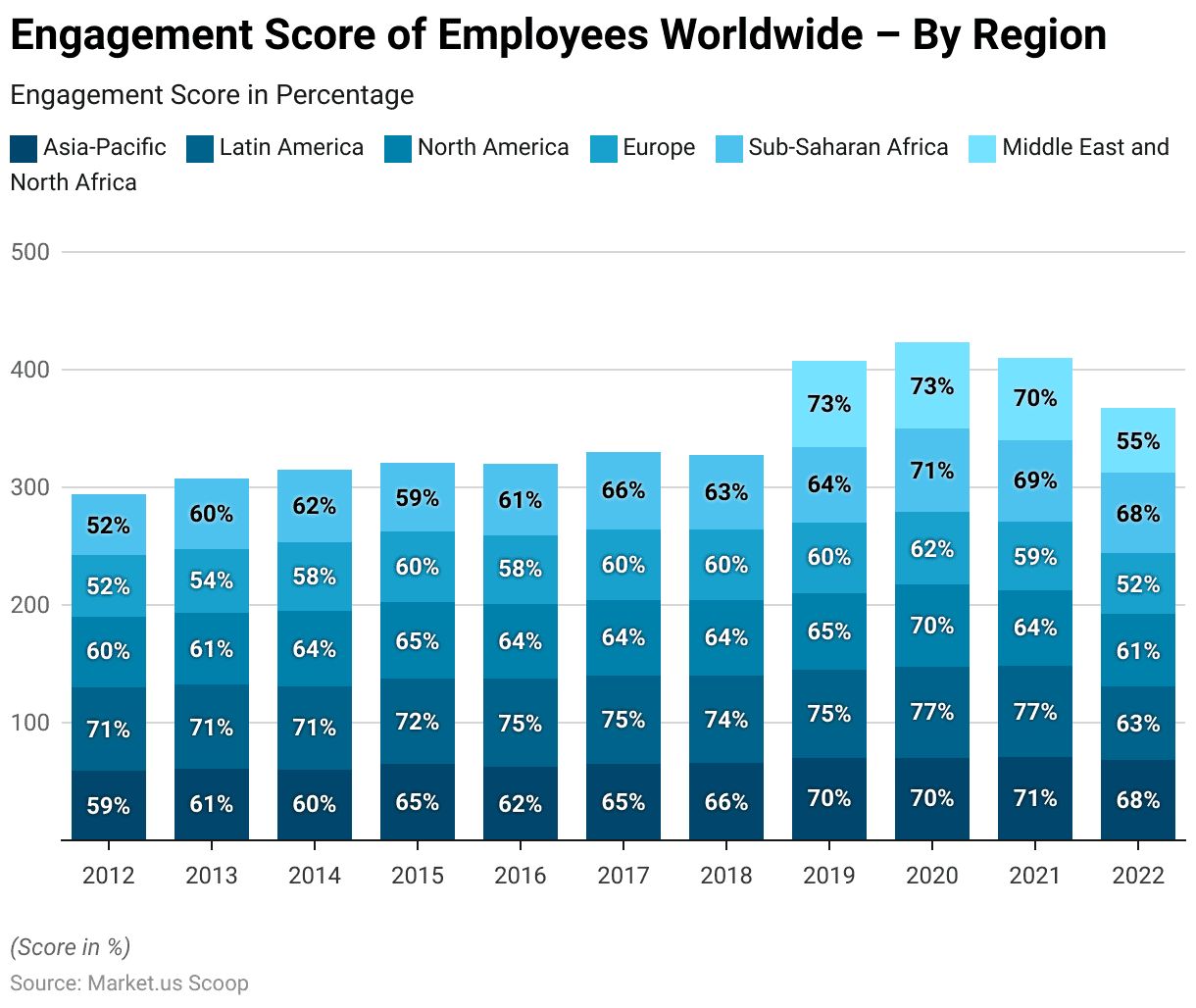
Employee Engagement Software Market Statistics
Global Employee Engagement Software Market Size Statistics
- The global employee engagement software market is projected to experience significant growth over the coming decade. With revenues steadily increasing year by year at a CAGR of 14.2%.
- In 2023, the market is valued at approximately USD 1.0 billion. This growth is expected to continue at a consistent pace. Reaching USD 1.1 billion by 2024 and further expanding to USD 1.3 billion by 2025.
- The upward trend is projected to accelerate, with the market size estimated to reach USD 1.5 billion in 2026 and USD 1.7 billion in 2027.
- By 2028, the global employee engagement software market is anticipated to generate USD 1.9 billion in revenue. Reflecting sustained demand for tools that enhance workforce productivity and satisfaction.
- This momentum is forecast to persist through 2029, with revenues climbing to USD 2.2 billion. The market is expected to hit USD 2.5 billion by 2030, marking a critical milestone.
- The growth trajectory does not stop there, as projections for 2031 estimate market revenues to reach USD 2.9 billion, with subsequent increases leading to USD 3.3 billion in 2032 and an impressive USD 3.8 billion by 2033.
- This steady increase highlights the growing importance of employee engagement platforms as companies increasingly prioritize employee experience and organizational efficiency. Overall, the market shows robust potential. Driven by technological advancements and the rising need for organizations to foster a productive and engaged workforce.
(Source: market.us)

Employee Engagement Software Market Size – By Deployment Mode Statistics
2023-2027
- The global employee engagement software market is forecasted to grow significantly from 2023 to 2027, with notable variation between cloud-based and on-premises deployment modes.
- In 2023, the total market is valued at USD 1.0 billion, with cloud-based solutions contributing USD 0.67 billion and on-premises solutions accounting for USD 0.33 billion.
- By 2024, the market is expected to reach USD 1.1 billion, with cloud-based deployments growing to USD 0.74 billion and on-premises solutions reaching USD 0.36 billion.
- This trend continues in 2025, where the market is projected to expand to USD 1.3 billion, with cloud-based software increasing to USD 0.87 billion and on-premises solutions rising to USD 0.43 billion.
- In 2026, the overall market size is anticipated to grow to USD 1.5 billion, with cloud-based deployments contributing USD 1.01 billion and on-premises solutions generating USD 0.50 billion in revenue.
- By 2027, the global market is estimated to reach USD 1.7 billion, with cloud-based revenue growing to USD 1.14 billion and on-premises rising to USD 0.56 billion.
2028-2033
- This growth is projected to accelerate in 2028, where the market is expected to hit USD 1.9 billion, with cloud-based software generating USD 1.27 billion and on-premises solutions reaching USD 0.63 billion.
- The market size continues to expand through 2029, with total revenue reaching USD 2.2 billion. Cloud-based solutions are forecasted to contribute USD 1.47 billion, while on-premises deployments grow to USD 0.73 billion.
- By 2030, the total market size is projected to reach USD 2.5 billion, with cloud-based solutions generating USD 1.68 billion and on-premises growing to USD 0.83 billion.
- The trend of growth remains robust into 2031, where the global employee engagement software market is expected to reach USD 2.9 billion, with cloud-based deployments contributing USD 1.94 billion and on-premises solutions accounting for USD 0.96 billion.
- By 2032, the market is forecasted to grow to USD 3.3 billion, with cloud-based revenue rising to USD 2.21 billion and on-premises solutions reaching USD 1.09 billion.
- Finally, by 2033, the global market is expected to reach USD 3.8 billion, with cloud-based solutions making up USD 2.55 billion of that total. While on-premises deployments are projected to generate USD 1.25 billion.
- The consistent growth in cloud-based deployment underscores its increasing dominance in the market. Driven by scalability, flexibility, and lower upfront costs. At the same time, on-premises solutions continue to serve organizations with specific control or security needs.
(Source: market.us)
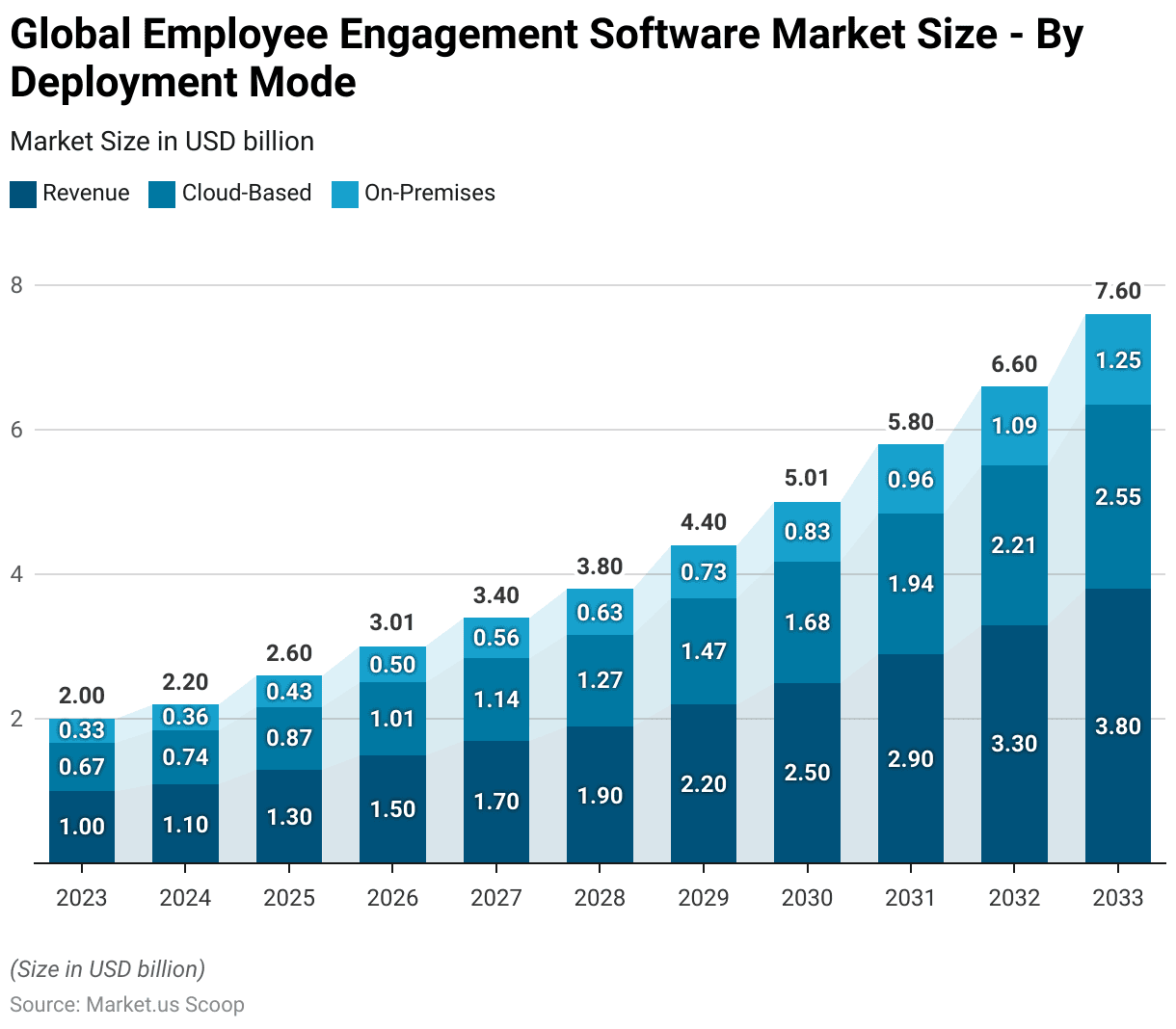
Global Employee Engagement Software Market Share – By Enterprise Size Statistics
- The global employee engagement software market is characterized by a significant disparity in market share when analyzed by enterprise size.
- Large enterprises dominate the market, accounting for 70.6% of the total market share. These organizations typically possess larger workforces and more extensive budgets. Allowing them to invest heavily in comprehensive employee engagement solutions to enhance productivity, employee retention, and organizational culture.
- In contrast, small and medium-sized enterprises (SMEs) hold a smaller portion of the market, representing 29.4% of the overall share. Although SMEs have a growing need for employee engagement software. Their limited resources compared to large enterprises influence their market participation.
- However, as the demand for flexible and cost-effective software solutions increases, particularly through cloud-based models. SMEs are expected to gradually expand their market presence in the future.
(Source: market.us)
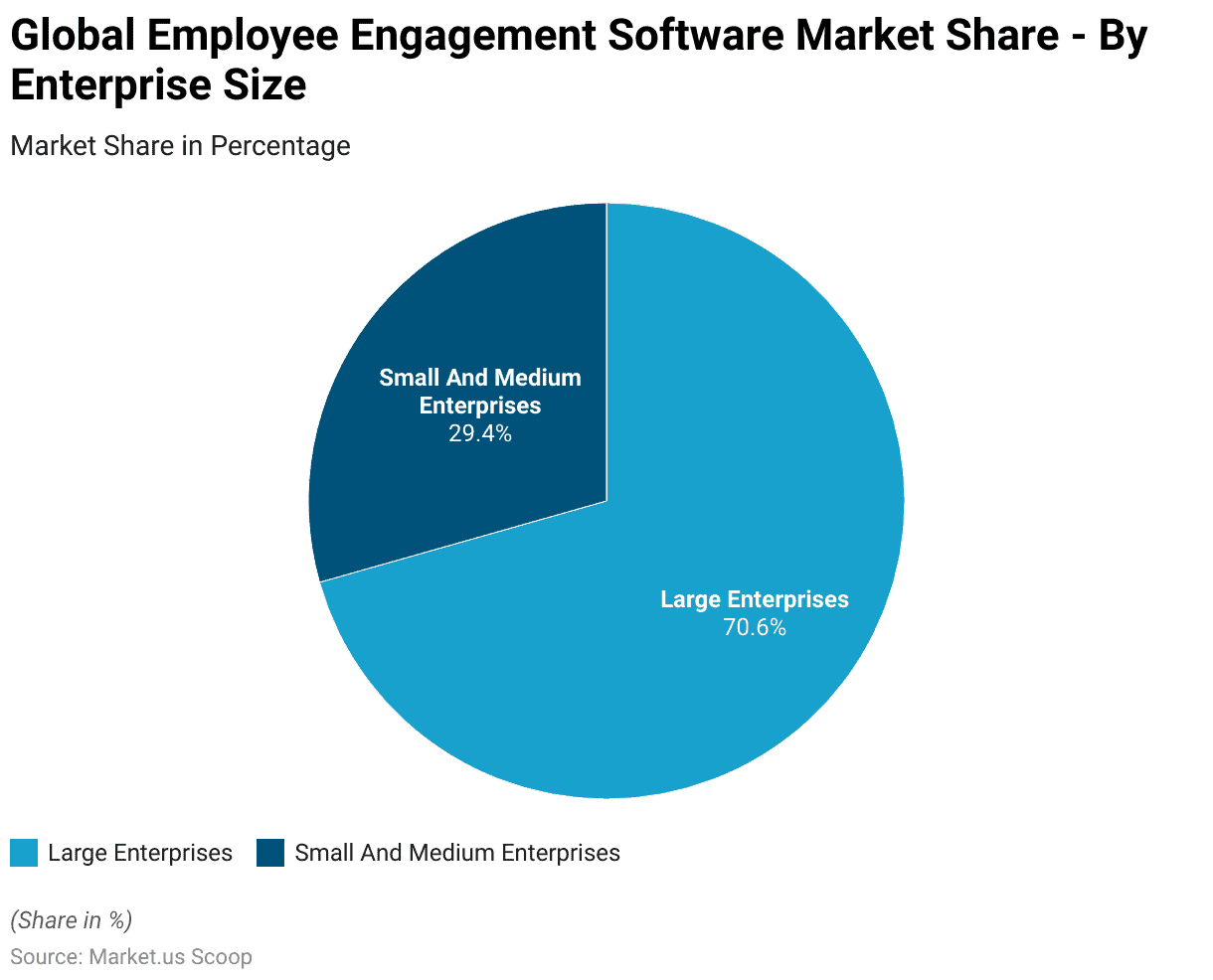
Most Important Attributes for Employees When Choosing a Job Worldwide
- As of 2023, employees worldwide prioritize several attributes when selecting a job.
- The most important factor, according to 45% of respondents, is the opportunity to engage in impactful work. This reflects a growing desire among employees to find meaning and purpose in their professional roles.
- Career advancement opportunities are also highly valued, with 43% of respondents emphasizing the importance of growth potential and professional development in their career decisions.
- Compensation that is aligned with performance is a critical consideration for 38% of employees. As is autonomy in the workplace, with the same percentage (38%) indicating the need for independence in managing tasks and decision-making.
- Flexible work arrangements, which have gained prominence in recent years, are also a top priority for 38% of employees. Highlighting the importance of work-life balance and the ability to adapt work schedules to personal needs.
- Additionally, 20% of respondents view clear performance metrics as an important factor. Seeking transparency in how success is measured and rewarded in the workplace.
- Finally, 16% of employees consider experience with the latest technology an essential attribute. Indicating a desire to remain at the forefront of innovation and utilize advanced tools in their roles.
- In summary, the data suggests that employees in 2023 are driven by the pursuit of meaningful work. Opportunities for growth, fair compensation, autonomy, and flexibility. While also valuing transparency in performance evaluations and access to cutting-edge technology.
(Source: Statista)
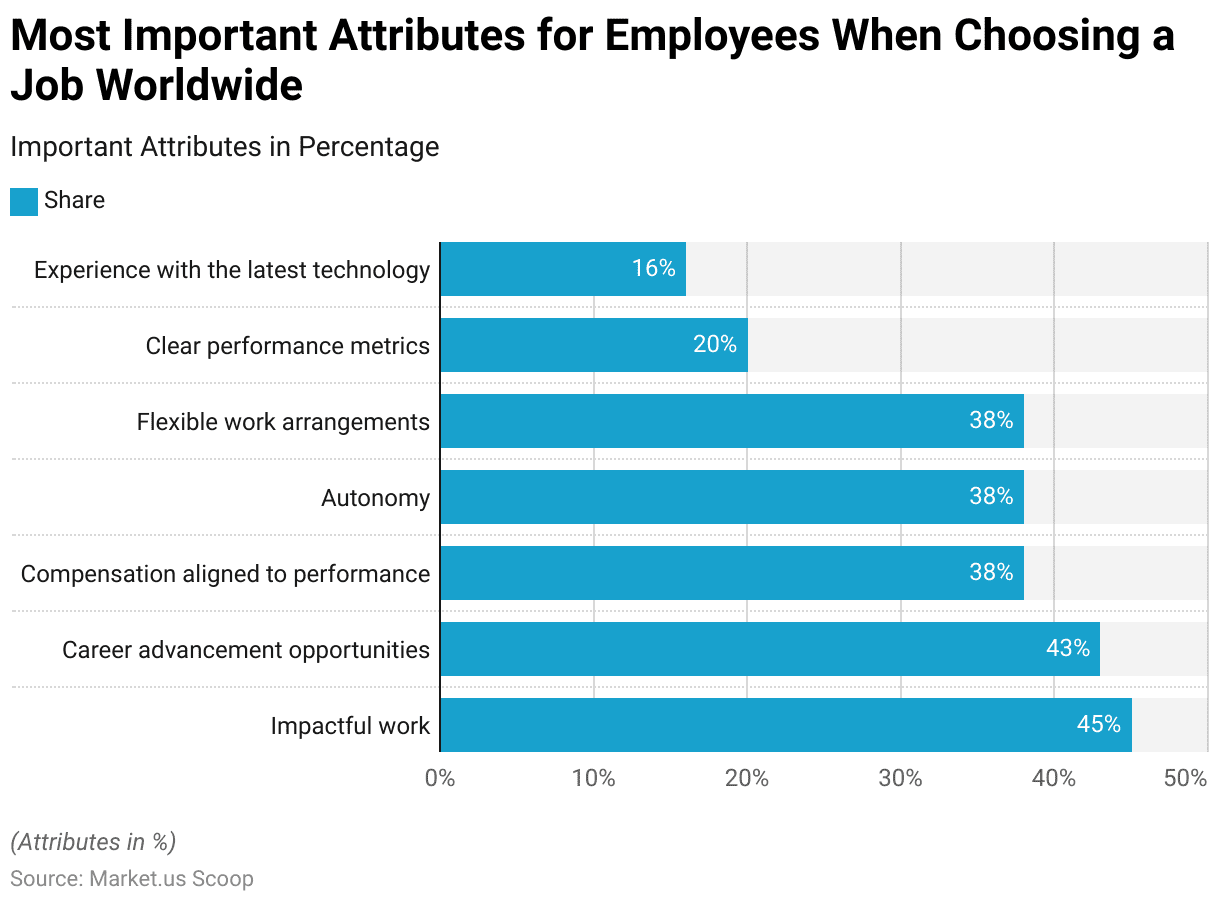
Employee Engagement Software in Delivering Customer Experience (CX) Worldwide – By Country Statistics
- In 2021, employee engagement in delivering customer experience (CX) varied significantly across different countries.
- Brazil led globally, with 62.5% of employees being highly engaged, followed by Kenya at 60.7%. Both countries had relatively low levels of disengagement, with only 3.1% of employees in Brazil and 2.4% in Kenya reporting not being engaged.
- In the Philippines, 56.7% of employees were highly engaged in delivering CX. While in the United States and South Africa, the figures stood at 53.7% and 53%, respectively. Both nations reported minimal or no disengagement. India followed with 51% of employees highly engaged, though 2.4% of respondents were not engaged.
- Malaysia saw 47.6% of employees highly engaged, but a higher percentage, 14.3%, were somewhat disengaged. Similarly, Saudi Arabia reported that 46.2% of employees were highly engaged, while 15.4% were somewhat disengaged. China also had 46% of employees highly engaged, and while none were reported as disengaged, 54% were somewhat engaged.
More Insights
- European countries showed varying engagement levels. In France and Italy, approximately 45% of employees were highly engaged, though both countries had some levels of disengagement. Italy reported no employees as “not engaged,” while France had 3.9% in this category. Belgium, with 44.7% of employees highly engaged, saw a slightly higher level of disengagement at 10.5%.
- Countries like Australia, Germany, and Japan reported lower levels of high engagement, with 40.7%, 39.1%, and 38.8%, respectively. Disengagement was more noticeable in these regions, particularly in Germany, where 21.7% of employees were somewhat disengaged.
- Canada, the United Kingdom & Ireland, and Singapore also reported lower engagement levels, with fewer than 40% of employees being highly engaged in each of these countries. However, they exhibited lower levels of outright disengagement.
- Poland and New Zealand had the lowest levels of high engagement, at 29% and 25%, respectively. Most employees in these countries fell into the “somewhat engaged” category.
- This data highlights significant regional differences in employee engagement with delivering customer experiences. Reflecting varying levels of organizational culture, workforce dynamics, and customer-centricity across countries.
(Source: Statista)
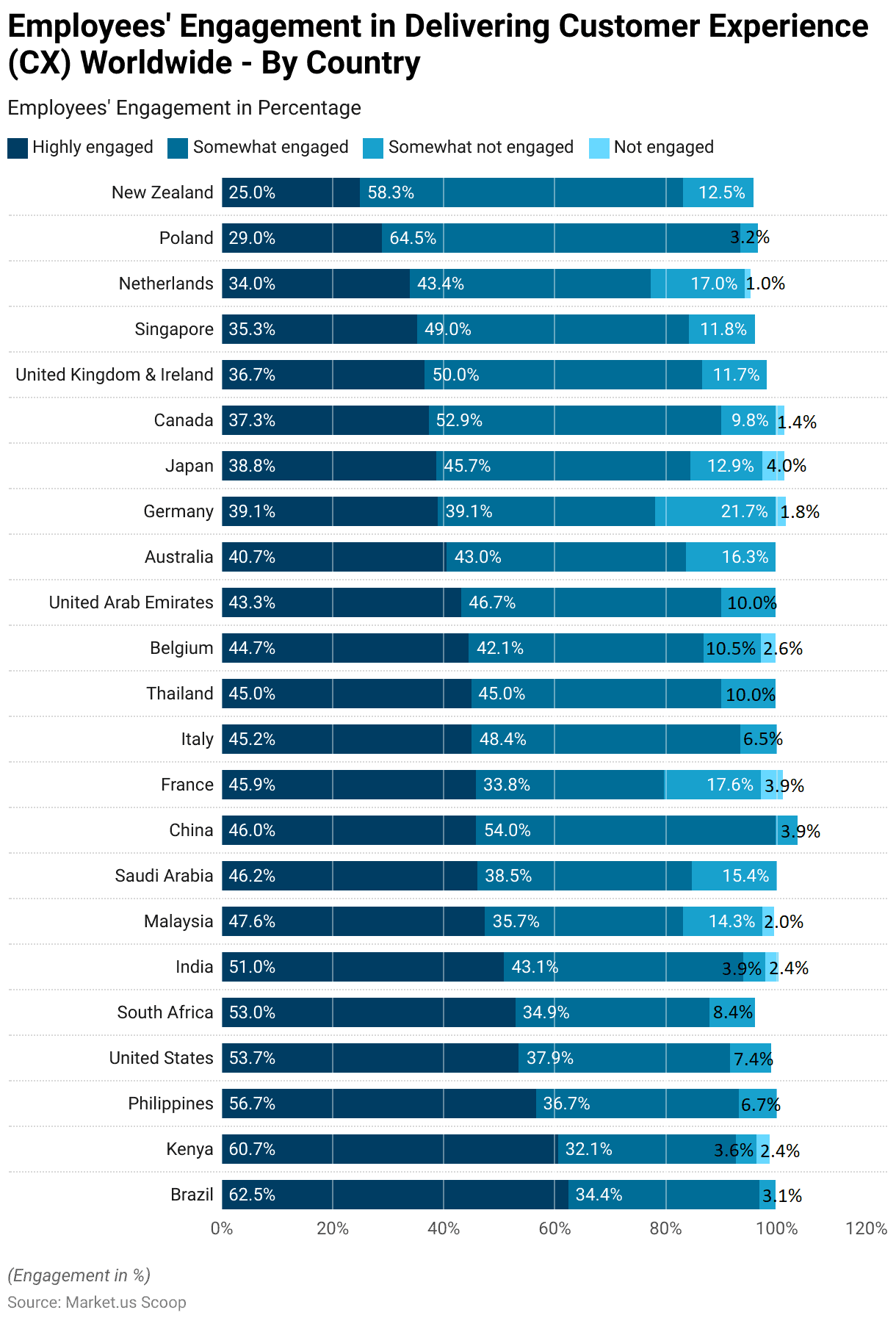
Job Satisfaction and Security Among Digital Workers Worldwide
- In 2022, job satisfaction and security among digital workers worldwide varied significantly depending on their level of digital proficiency.
- Advanced digital workers reported the highest levels of both job satisfaction and job security, with 72% of respondents in this category rating each aspect an eight or higher on a 0-10 scale.
- This indicates that workers with advanced digital skills are more likely to feel content in their roles and confident about their job stability.
- For intermediate digital workers, job satisfaction was notably lower, with only 48% of respondents rating their satisfaction as an eight or higher. While 53% felt similarly about their job security.
- This suggests a moderate level of confidence and satisfaction among those with intermediate digital skills. Though not as high as their advanced counterparts.
- Basic digital workers, those with the least digital proficiency, reported the lowest levels of job satisfaction and security. Only 43% of these workers rated their job satisfaction an eight or higher. While 48% felt the same about their job security.
- These figures reflect a greater sense of uncertainty and lower satisfaction levels among workers with minimal digital skills. Underscoring the importance of digital proficiency in both job satisfaction and perceived job stability.
(Source: Statista)
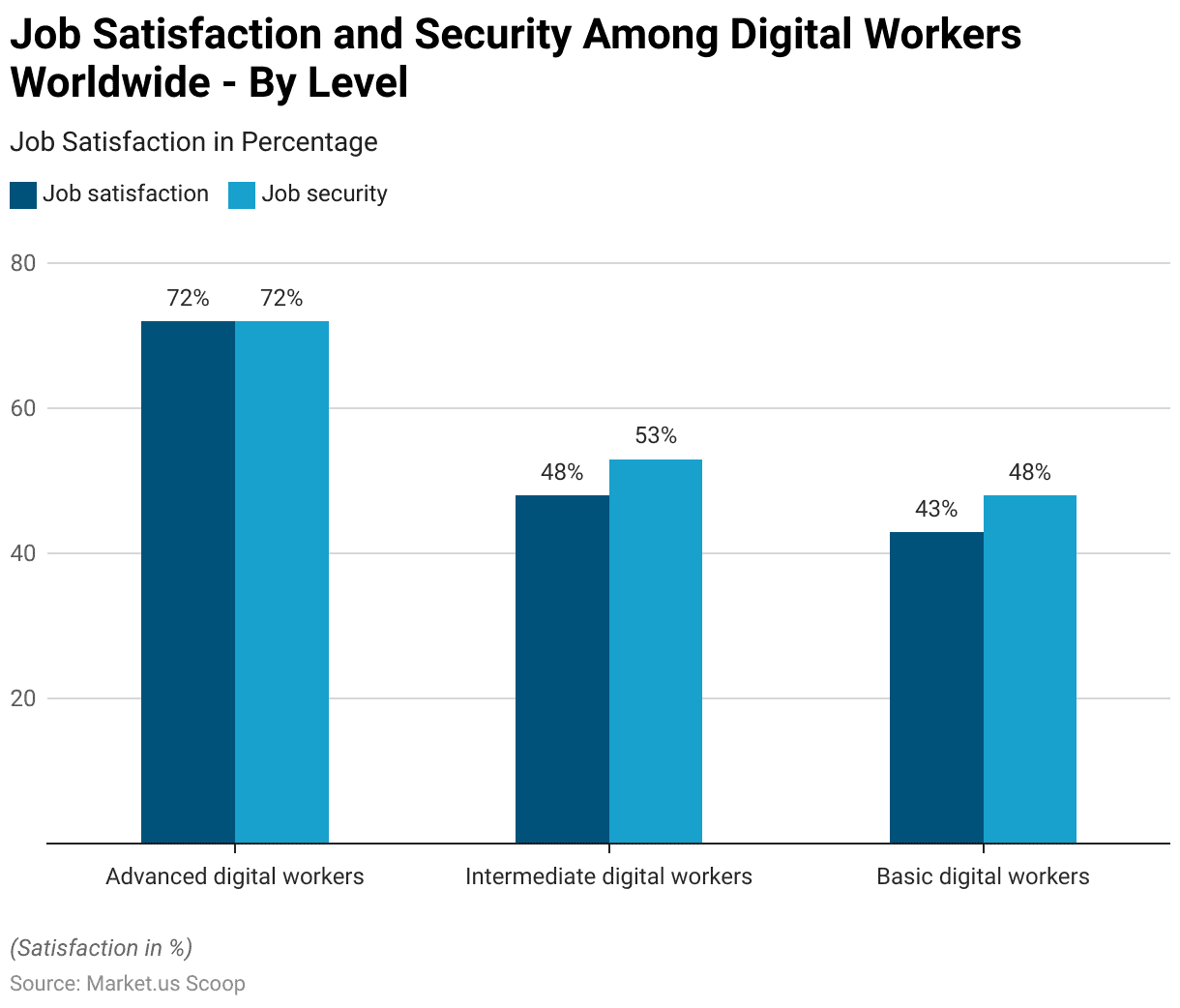
Engaging Training Formats for Employees
- In 2023, employees in the United States identified various training formats that they found particularly engaging.
- Leading the list were training videos that could be watched anytime, with 65% of respondents indicating this format as highly engaging.
- Closely following were in-person, instructor-led sessions scheduled at specific times, with 63% of employees finding this approach effective for their learning.
- Several virtual formats also proved popular, with 59% of respondents highlighting virtual. Instructor-led sessions that could be watched at any time and an equal percentage favored online eLearning courses featuring quizzes and game elements that are available anytime.
- Additionally, 56% of respondents appreciated virtual, instructor-led sessions that took place at scheduled times.
- Group projects and role-playing activities engaged 53% of employees, offering interactive and collaborative learning experiences.
- Simulations, which create realistic environments for practicing skills. Were favored by 50% of employees. As were digital PDFs or web copies that could be read at any time. Providing flexibility for self-paced learning.
- Overall, the data reveals that employees value a diverse range of training formats, with a strong preference for flexibility. Interactive elements, and both virtual and in-person learning options. This highlights the importance of offering varied training methods to meet different employee needs and preferences.
(Source: Statista)

Main Reasons for Using Online Feedback Tools in Organizations
- In 2019, organizations in the Netherlands identified several key reasons for utilizing online feedback tools.
- The most cited reason, with 28% of respondents, was to increase employee involvement. Emphasizing the importance of engagement in the workplace.
- Stimulating behavioral change within the organization was also a significant driver, with 26% of organizations implementing feedback tools for this purpose.
- Additionally, 24% of respondents used these tools to stimulate a change in organizational culture. Reflecting a focus on aligning the workforce with evolving company values.
- Lowering the barrier for requesting and giving feedback was another notable reason, with 23% of organizations seeing online tools as a way to foster open communication.
- Furthermore, 21% of respondents utilized feedback tools to gather better input for evaluations and performance discussions, while an equal percentage used them to gain insights into employees’ talents.
- Other motivations included gaining insights into employee achievements and performance (20%). As well as understanding potential areas for development and employee needs (18%).
- An additional 18% of respondents highlighted the importance of actively working towards organizational objectives and giving employees more control over their development.
- Lastly, 16% of organizations cited the need to move with the times and meet the expectations of younger employees as a reason for adopting online feedback tools.
- These findings underscore the growing importance of feedback mechanisms in driving employee engagement, performance management, and organizational growth.
(Source: Statista)
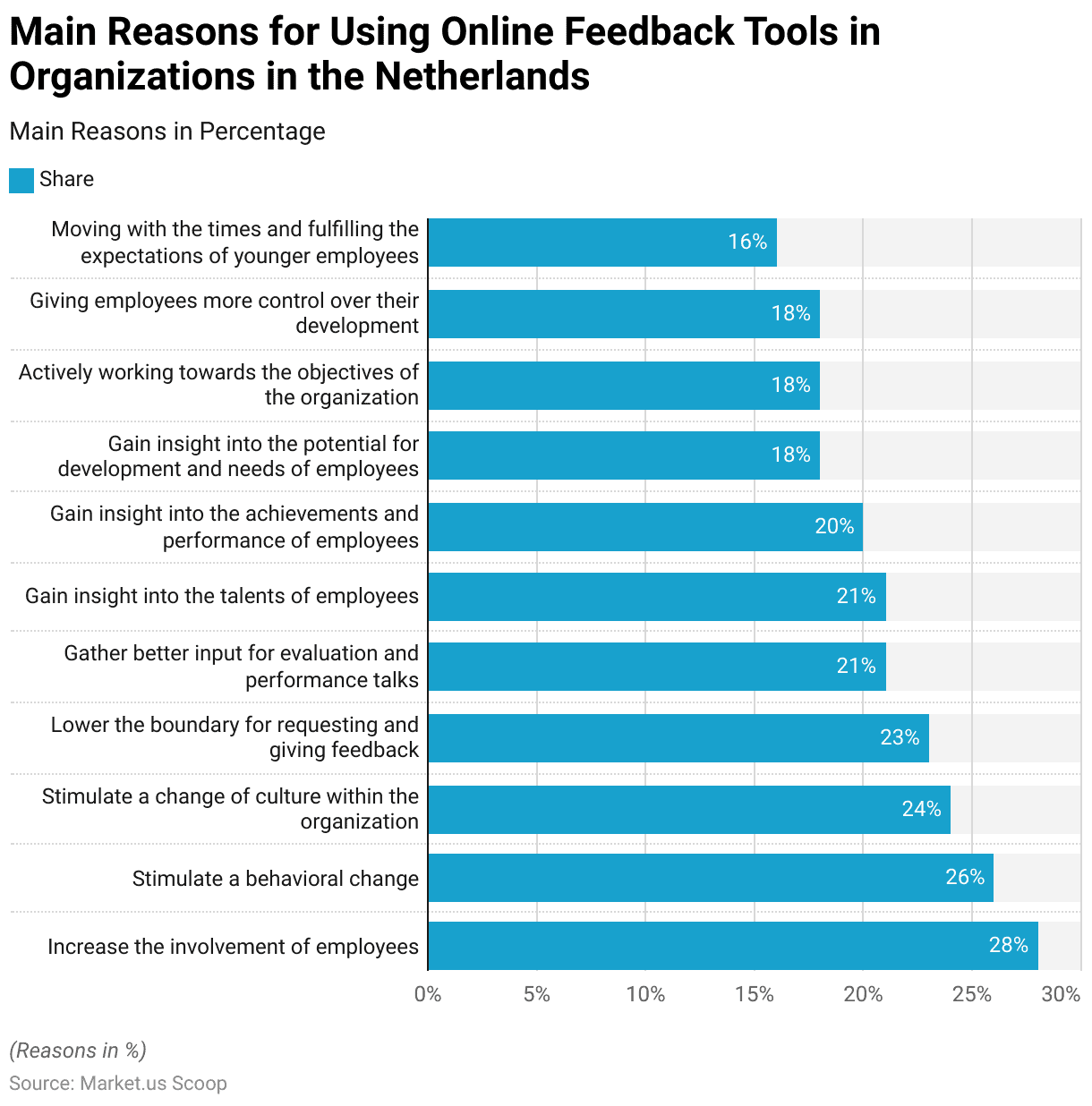
Use of Social Media in Employee Training
- In 2023, various social media platforms were utilized by companies in the United States for employee training.
- The most commonly used platform was YouTube, with 49% of respondents incorporating it into their training programs.
- Facebook followed with 37%, while Instagram was used by 33% of companies.
- LinkedIn, a platform often associated with professional development, was employed by 30% of respondents.
- Additionally, X (formerly known as Twitter) was used by 28% of organizations, and TikTok, a newer platform for sharing short-form content, was used by 26%.
- Other platforms were used by 4% of respondents.
- Interestingly, 28% of companies reported not using social media at all for employee training. Indicating that a significant portion of organizations either rely on traditional methods or are yet to explore social media as a training tool.
- This data highlights the growing role of social media in professional development, with platforms like YouTube and LinkedIn playing a central role in delivering training content to employees.
(Source: Statista)
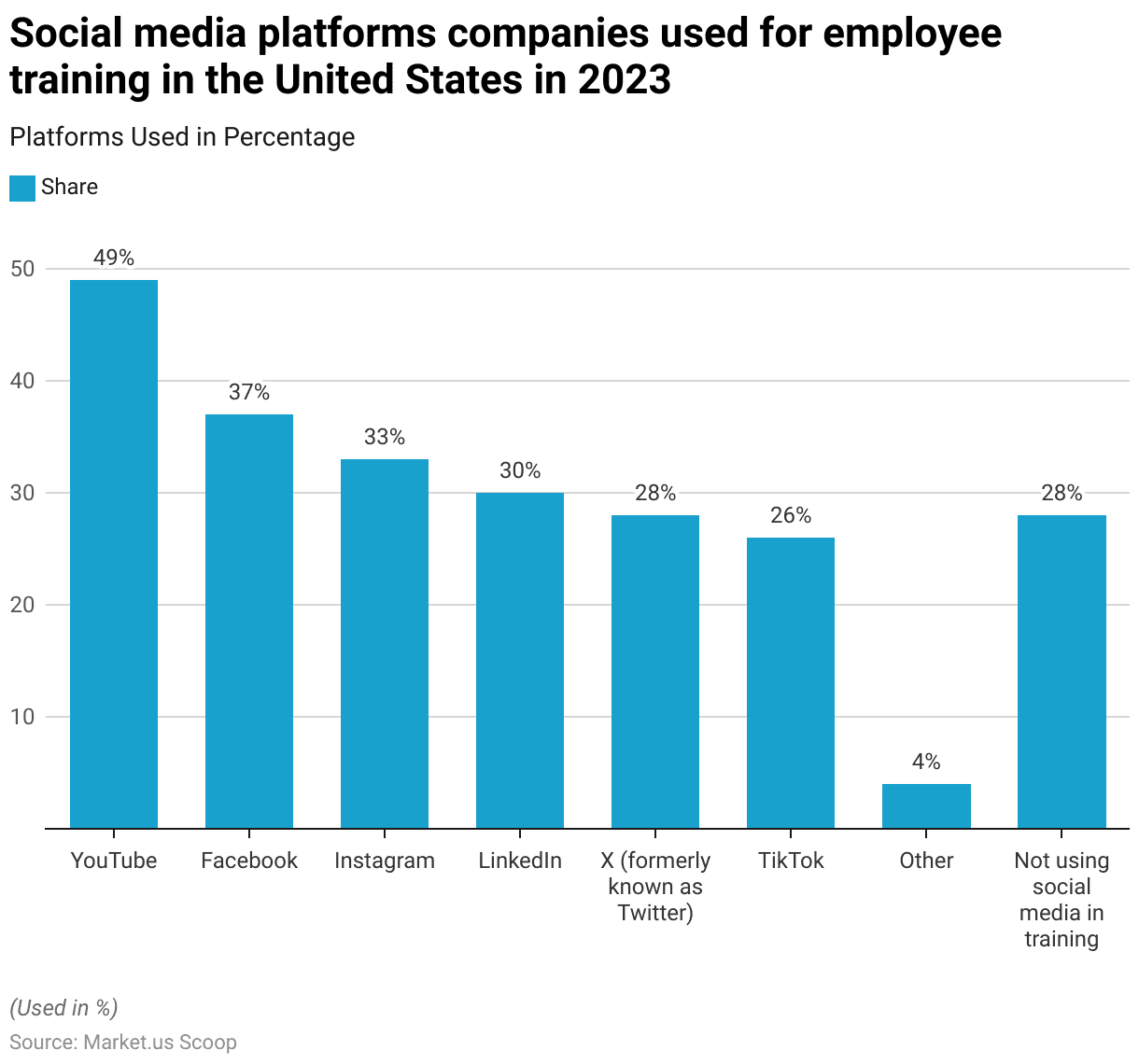
Work Environment Benefits Through Technology
- In 2020, employees identified several technologies that would significantly improve their work environment.
- According to respondents, collaboration devices that automatically recognize users and pair with their devices, such as laptops, tablets, and phones. Were seen as highly beneficial, with 57% of employees indicating this would enhance their workspace.
- Wireless screen-sharing technology was equally valued, also receiving 57% support.
- Digital signage, which can display important alerts related to cleanliness, availability, company news, and other technological capabilities, was favored by 55% of respondents.
- Additionally, 47% of employees believed that digital office navigation tools. Which assist in finding meeting rooms and navigating the workspace, would provide meaningful benefits.
- Voice-controlled technologies are also prominently featured, with 45% of employees expressing that a voice-controlled meeting assistant for touchless control would improve their work environment.
- Meanwhile, 35% of respondents saw value in voice-controlled meeting room booking systems.
- A small portion, 4%, reported that none of these technologies would benefit their work environment. Indicating that the majority of employees saw potential improvements through the adoption of these digital tools.
- Overall, the data highlights a growing demand for smart, touchless, and automated technologies that can streamline tasks and enhance workplace efficiency.
(Source: Statista)

Employee Satisfaction with Reskilling and Upskilling Training at their Workplace
- In 2024, employee satisfaction with reskilling and upskilling training in the workplace in the United States showed generally positive feedback.
- A majority of employees were satisfied with the training opportunities provided by their employers. With 27% of respondents stating that they were very satisfied and an additional 44% reporting that they were satisfied.
- However, a portion of the workforce remained neutral, as 13% of respondents expressed indifference toward the reskilling and upskilling programs offered.
- On the other hand, dissatisfaction was noted among some employees, with 11% indicating that they were dissatisfied. While 6% expressed that they were very dissatisfied with the training opportunities at their workplace.
- Overall, the data highlights a generally favorable view of reskilling and upskilling initiatives. However, there is room for improvement in addressing the concerns of dissatisfied employees.
(Source: Statista)
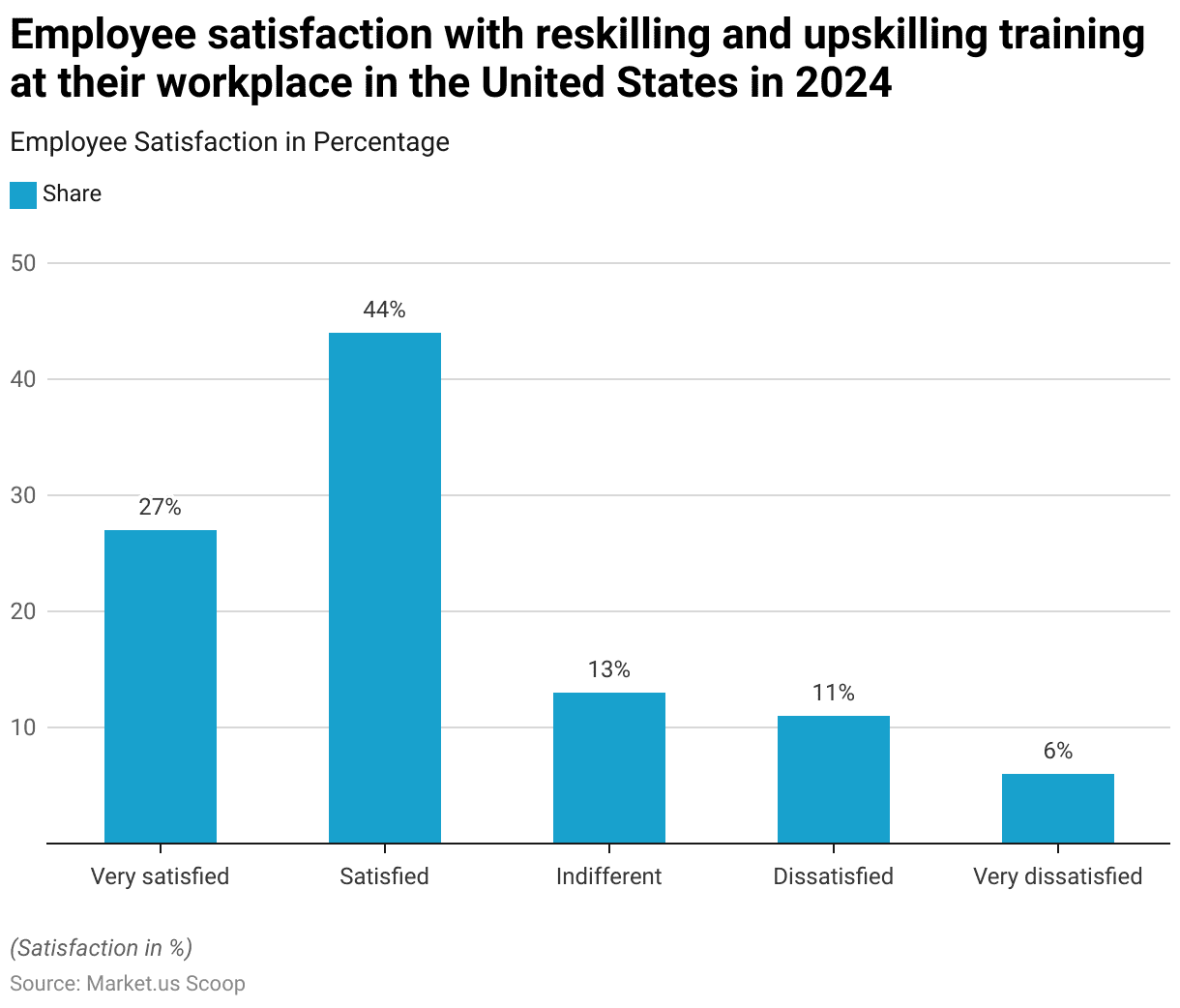
Key Spending and Investments
Spending On Workplace Training By Employee Engagement Software Statistics
- From 2008 to 2022, the average global spending on workplace training per employee fluctuated. Showing a general upward trend over the years.
- In 2008, the average spend per employee was USD 1,068, which slightly increased to USD 1,081 in 2009.
- A notable rise occurred in 2010, with spending reaching USD 1,228, although it dipped to USD 1,182 in 2011.
- From 2012 onwards, the spending gradually increased, starting at USD 1,195 in 2012 and reaching USD 1,229 in 2014.
- By 2015, it climbed further to USD 1,252, followed by steady growth in the subsequent years. Hitting USD 1,273 in 2016 and USD 1,296 in 2017.
- The upward trend continued, with spending peaking at USD 1,308 in 2019.
- However, the impact of global events in 2020 led to a decline, with spending dropping to USD 1,267. It slightly recovered in 2021, reaching USD 1,280, but dropped again to USD 1,220 by 2022.
- Despite some fluctuations, the overall trend reflects a general commitment to investing in employee training over the long term.
(Source: Statista)

Company Investment Plans Regarding Recruiting Procedures Worldwide By Employee Engagement Software Statistics
- In 2024, companies worldwide plan to focus their recruiting investments on several key procedures.
- Leading the list, 33.23% of respondents indicated plans to invest in AI tools, reflecting the growing importance of automation and machine learning in recruitment processes.
- Talent retention is also a priority, with 20.4% of companies allocating resources to keep valuable employees.
- Improving the candidate’s experience is cited by 18.78%. Followed by expanding the talent pool (18.33%) to attract a broader range of candidates.
- Investments in candidate assessment, such as screening and interviewing. It was noted by 15.74%, while employer branding initiatives aimed at strengthening. A company’s reputation attracted 15.41% of investment plans.
- Efforts to promote talent diversity account for 14.44%, and 10.1% of companies are focusing on HR analytics to derive insights from employee data. Investments in non-AI HR technology and tools stand at 9.65%.
- Recruitment marketing, designed to enhance outreach efforts, received 9.33%, while 9.26% of companies plan to invest in reskilling or upskilling employees to meet hiring goals.
- Collaborative hiring processes account for 8.29%, and social recruiting initiatives aimed at leveraging social media for recruitment attracted 7.77% of investment plans.
- Finally, 6.93% of companies plan to focus on GDPR compliance, with an additional 6.93% falling into other categories.
- These investment plans highlight the growing use of technology, especially AI, alongside a continued focus on improving talent retention, candidate experience, and diversity.
(Source: Statista)

Areas for Investment in Productivity Improvement Worldwide by Employee Engagement Software Statistics
- In 2024, organizations worldwide plan to invest in various areas to boost productivity.
- Leading the priorities is employee upskilling and reskilling, with 51% of respondents focusing on enhancing workforce skills.
- Initiatives to support physical and mental well-being rank second, with 45% of organizations prioritizing employee health.
- Process optimization and workflow management are closely followed at 44%. While 40% plan to invest in generative AI technologies to drive productivity improvements.
- Simplifying organizational structures is a focus for 37% of companies, while 34% are investing in workforce deployment platforms to allocate resources better.
- Cybersecurity measures aimed at preventing disruptions are a priority for 31% of respondents.
- Additionally, 27% plan to implement self-service solutions for routine information, while workforce monitoring and feedback systems account for 25%.
- Finally, 22% of companies are investing in work redesign efforts to optimize their operations further.
- These investments highlight a balanced approach between technology-driven solutions like AI and cybersecurity and employee-centric initiatives. Like upskilling and well-being aimed at driving overall productivity in the workplace.
(Source: Statista)
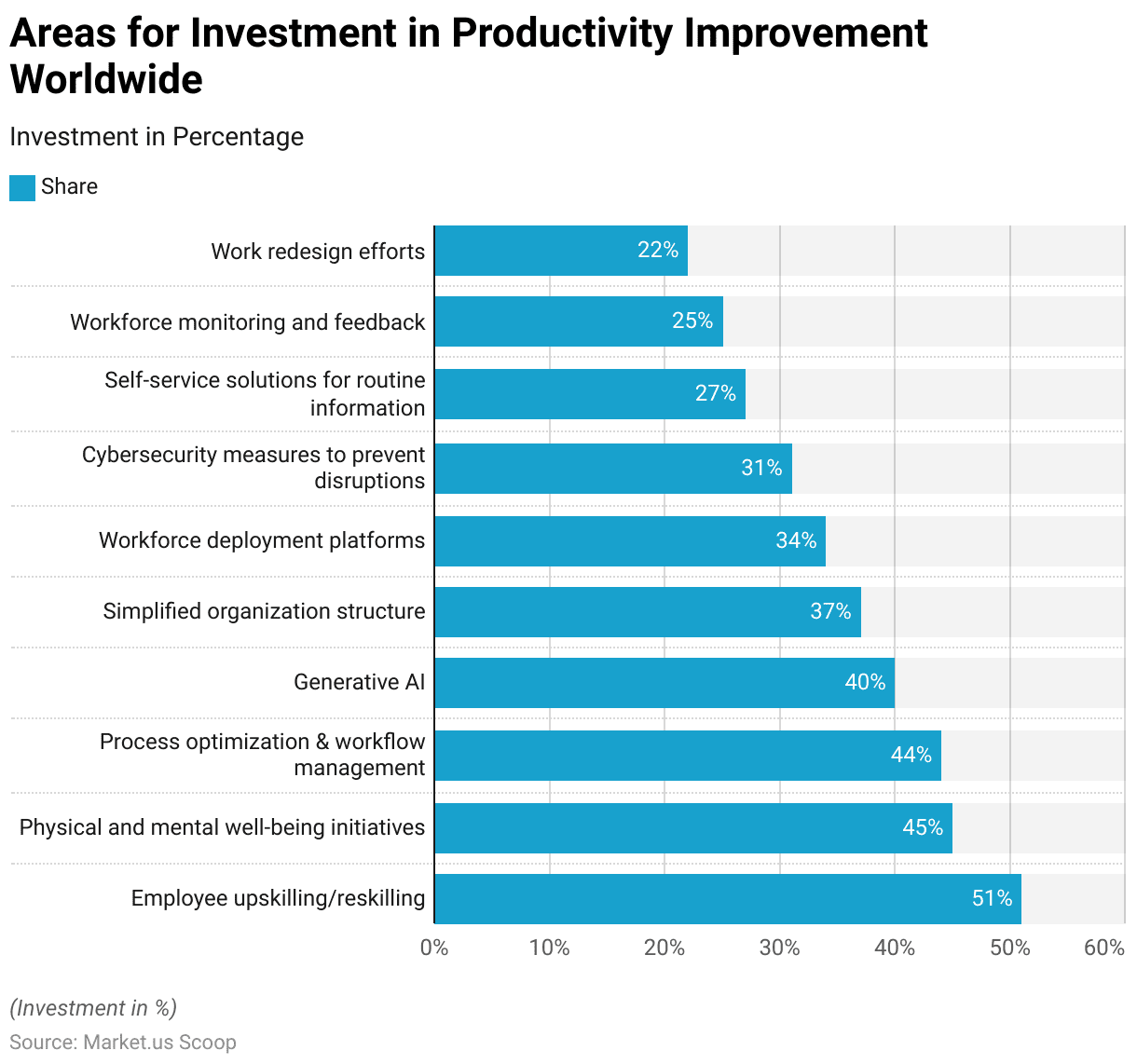
Challenges and Concerns
- In 2020, learning and development (L&D) professionals worldwide faced several significant challenges in fostering effective learning within organizations.
- The most prominent challenge, cited by 49% of respondents, was getting managers to prioritize learning for their teams, emphasizing the critical role leadership plays in promoting employee development.
- Creating a culture of learning was the second most common challenge, with 42% of L&D professionals identifying this as a hurdle in their efforts to encourage continuous education in the workplace.
- Increasing employee engagement in learning was another concern for 36% of respondents, indicating difficulties in motivating employees to participate in training programs actively.
- Furthermore, 31% of L&D professionals reported challenges in teaching employees to use technology more effectively, reflecting the growing importance of digital skills in modern workplaces.
- Scaling learning across the organization was noted as a challenge by 26% of professionals. Highlighting the complexities of expanding training efforts to reach all employees.
- Additionally, 22% of respondents faced difficulties in understanding what skills to build or which courses to recommend, as well as ensuring learners knew where to find learning resources.
- Other challenges included demonstrating the value of learning (21%) and identifying skill gaps (21%), both of which are crucial for justifying investment in training initiatives and tailoring programs to meet specific needs.
- Lastly, 17% of respondents found it difficult to secure executive buy-in for learning programs, underscoring the need for leadership support in driving organizational learning strategies.
- These findings illustrate the multifaceted nature of the challenges faced by L&D professionals, from leadership involvement to employee engagement and the logistics of scaling learning programs effectively.
(Source: Statista)

Innovations and Developments in Employee Engagement Software Statistics
- In the evolving landscape of employee engagement software, significant innovations and developments are driving enhanced workplace experiences.
- A key trend observed in 2024 is the integration of AI to personalize and enhance the engagement process.
- For instance, platforms like Lattice and Leapsome are deploying AI-driven analytics to offer deep insights into employee behavior and to customize the onboarding experience for new hires, making it more engaging and informative.
- Another noteworthy innovation is the rise of comprehensive platforms like Workvivo, which combine social interaction, recognition, and comprehensive analytics into a single solution.
- This type of software facilitates a more connected and interactive environment, which is especially critical in remote and hybrid work settings.
- Similarly, tools like Eletive and Peoplebox focus on continuous feedback and pulse surveys that help organizations gauge employee sentiment in real time, allowing for timely and effective interventions.
- Moreover, advancements in mobile accessibility and integration capabilities are exemplified by apps that embed HR functionalities into commonly used platforms like Slack and Microsoft Teams, ensuring that employee engagement tools are more accessible and seamlessly integrated into daily workflows.
- These innovations collectively foster a more dynamic, responsive, and engaging workplace environment, crucial for maintaining high levels of employee satisfaction and productivity.
(Sources: Unite.AI, People Managing People, EPILOGUE SYSTEMS)
Regulations for Employee Engagement Software Statistics
- Regulations governing employee engagement software vary significantly by country, reflecting diverse legal frameworks concerning data protection, accessibility, and labor laws.
- In the European Union, for example, the General Data Protection Regulation (GDPR) mandates strict controls on data privacy and consent management, necessitating that organizations obtain clear consent from employees before collecting or processing their data.
- The software must also include features allowing employees to manage their consent preferences easily.
- In the United States, compliance with the Americans with Disabilities Act (ADA) and Section 508 of the Rehabilitation Act is critical. These laws ensure that employee engagement software is accessible to individuals with disabilities, incorporating accessibility features such as text alternatives for images and videos, as well as keyboard navigation options.
- Moreover, the evolving landscape of global digital accessibility standards, such as the Web Content Accessibility Guidelines (WCAG), also impacts how organizations globally should design and update their engagement platforms to be accessible to all users, irrespective of their physical abilities.
- Different countries may have additional specific requirements. For instance, in Canada, alongside privacy and accessibility, bilingual language provisions might be necessary, while countries like Switzerland might emphasize data security due to stringent local privacy laws.
- Keeping up with these varied requirements not only ensures legal compliance but also enhances the effectiveness of engagement strategies by making them inclusive and respectful of local norms and legal expectations.
(Source: CIO Bulletin, Adherents – Welcome to The Show Pod, HR Magazine)
Recent Developments
Acquisitions and Mergers:
- Qualtrics acquires Clarabridge: In 2023, Qualtrics, a leader in experience management software, acquired Clarabridge, a customer experience and employee engagement platform, for $1.1 billion. This acquisition aims to enhance Qualtrics’ offerings in employee engagement by integrating Clarabridge’s AI-driven insights and analytics capabilities.
- SAP SuccessFactors merges with Emplify: In early 2024, SAP SuccessFactors announced a merger with Emplify, an employee engagement platform focused on measuring and improving employee morale. The merger is valued at $300 million and aims to enhance SAP’s engagement tools with more robust feedback mechanisms.
New Product Launches:
- Microsoft introduces Viva Engage: In mid-2023, Microsoft launched Viva Engage, a new employee engagement tool integrated into its Microsoft Teams platform. This tool allows employees to share stories, recognize peers, and engage in meaningful conversations, aiming to boost workplace culture and engagement.
- Workday unveils Workday Peakon Employee Voice: In late 2023, Workday launched the updated version of its employee engagement tool, Workday Peakon Employee Voice. Which includes advanced analytics and sentiment analysis features. This upgrade aims to provide real-time insights into employee engagement levels, helping organizations make informed decisions.
Funding:
- 15Five raises $30 million for performance management tools: In 2023, 15Five, an employee engagement and performance management platform, raised $30 million in Series D funding. The funds will be used to enhance its platform features and expand its market presence in the U.S. and international markets.
- Officevibe secures $15 million for product development: In early 2024, Officevibe, a popular employee engagement software. Raised $15 million to develop new features focused on team collaboration and feedback. This funding will support the company’s goal of improving employee satisfaction and productivity.
Technological Advancements:
- AI-driven employee engagement tools: By 2025, it is projected that 40% of employee engagement software will incorporate AI to provide personalized feedback and insights. Helping organizations tailor their engagement strategies more effectively.
- Integration of gamification in engagement platforms: The use of gamification features in employee engagement tools is on the rise. By 2026, 30% of companies are expected to adopt gamified elements in their engagement software to enhance motivation and participation among employees.
Conclusion
Employee Engagement Software Statistics: The employee engagement software market is expected to grow steadily. Organizations prioritize enhancing employee experience, productivity, and retention.
Cloud-based solutions are anticipated to dominate due to their flexibility and cost-effectiveness, particularly for SMEs. While large enterprises continue to hold a majority market share.
Key trends include AI integration, advanced analytics, and mobile platforms, which offer deeper insights into employee behavior.
The rise of hybrid and remote work has further increased the demand for tools that support communication and engagement.
Overall, investing in these solutions will likely lead to improved employee satisfaction and business performance.
FAQs
Employee engagement software is a digital platform designed to help organizations improve employee satisfaction, productivity, and retention by facilitating communication, feedback, recognition, and collaboration across teams.
Key features typically include real-time feedback, employee recognition tools, surveys and polls, performance management, collaboration platforms, analytics, and mobile accessibility to keep employees engaged regardless of their location.
It improves employee satisfaction, enhances communication, fosters a positive workplace culture, increases productivity, and reduces turnover. It also provides management with insights into employee sentiment and helps address potential issues proactively.
Cloud-based deployment is generally preferred due to its flexibility, scalability, and cost-effectiveness. It also allows remote and hybrid teams to access the platform easily. However, on-premises deployment may be suitable for organizations with strict data security or control requirements.
Organizations of all sizes and across various industries can use employee engagement software. It is beneficial for HR teams, managers, and executives looking to improve engagement, satisfaction, and overall employee performance.
It facilitates communication, collaboration, and recognition across distributed teams. It offers tools like real-time messaging, surveys, and virtual recognition that keep remote employees connected and engaged with their teams and company culture.
The software provides insights into employee sentiment, engagement levels, and performance trends through data-driven reports and dashboards. It helps identify areas for improvement and tracks the effectiveness of engagement initiatives over time.
Discuss your needs with our analyst
Please share your requirements with more details so our analyst can check if they can solve your problem(s)



